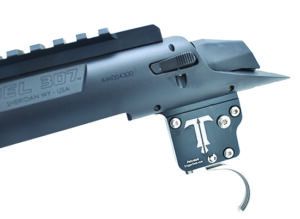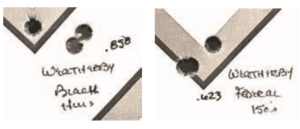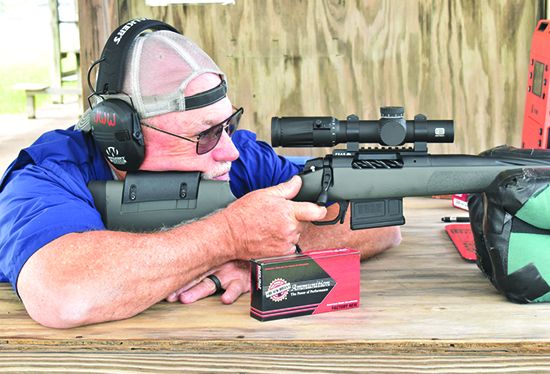Capable of taking most North American game at reasonable ranges and hitting steel or paper at more extended distances, the 308 Winchester is a favorite of bolt-gun shooters across the country, and we think that a good 308 Win. belongs in just about every well-equipped battery. We found a couple of new rifles chambered in 308 Win. that we wanted to shoot, the first of which is the latest offering from Weatherby, fresh from their new factory in Sheridan, Wyoming. The Model 307 Range XP, $1150, sports a 22-inch stainless-steel fluted barrel, muzzle brake, TriggerTech trigger, and a polymer stock with some very interesting features. The second sample is Ruger’s Second Generation American Rifle 46902, $620. We’ve reported on American Rifles several times in the past, consistently noting that they punch above their weight class. From what we see in the Gen 2’s redesigned stock and barrel, it looks like Ruger may have moved this rifle up to a heavier division.
At the range, we fired three different loads with three different bullet weights and, potentially, three different recoil levels. The first was a Hornady Custom Lite 125-grain SST reduced-recoil load, followed by a 150-grain PowerShok from Federal. Our heaviest load was Black Hills Ammunition’s 168 grain Open Tip Match. As usual, these cartridges came from Ammoseek.com, where the selection of available ammo is outstanding. Here’s how the rifles performed:
Weatherby Model 307 Range XP 3WRXP308NR4B 308 Winchester
$1150
Gun Tests grade: A-
Weatherby tried to use the best elements from the very popular Remington 700 design and correct its shortcomings. We think they did a great job on this new rifle line.

| Action Type | Bolt |
| Overall Length* | 41.5 in. |
| Barrel | 22 in. long, 1:10 in. twist |
| Overall Height** | 7.5 in. |
| Weight Unloaded | 7.14 lbs. |
| Weight Loaded*** | 7.66 lbs. |
| Sight Radius | NA |
| Action | Graphite Black Cerakote-finished steel |
| Barrel | Graphite Black Cerakote-finished steel |
| Magazine Capacity | 5 |
| Magazine Type | AICS-compatible Detachable Box |
| Stock | Polymer |
| Drop at Comb | Adjustable |
| Drop at Heel | Adjustable |
| Bedding | Pillar on action screws |
| Buttplate | Soft rubber |
| Length of Pull**** | 13.5 to 14.0 in. |
| Receiver Scope-Base Pattern | Picatinny rail |
| Trigger Pull Weight | 2.34 lbs. |
| Safety | 2-position thumb rocker |
| Warranty | Limited lifetime, original owner |
| Telephone | (307) 675-7840 |
| Website | Weatherby.com |
| Made In | U.S. |
* 43.25 in. with brake. ** without rings. *** 5+1 168-grain rounds. ****adjustable with spacers.
A few years ago, Weatherby, Inc. closed out its operation in California and moved to Sheridan, Wyoming. Once known for their Hollywood glitz and high-speed proprietary cartridges, Weatherby moved to a different climate and a different culture then set out to make the best use of both.
Their latest offering is the Model 307. Designed by the staff in Wyoming (307 is the local area code), Weatherby wanted to make the best possible use of new manufacturing techniques to make a great rifle compatible with the existing aftermarket parts of the Remington 700.
The action, bottom metal, and top screws (which are 8-40 specs) are all on the Model 700 pattern. The action is cylindrical, which simplifies some important things like mounting a scope. The trigger is from TriggerTech. Our sample was adjusted down as low as it could go and required a very consistent 2.3 pounds of compression to activate. This trigger came with a curved shoe, though we have to profess our love for the flat version.

The two-lug bolt is fluted and uses a plunger-style ejector as does the Remington, but the 307 employs a greatly improved AR-style extractor. The bolt release is on the left rear side of the action, another improvement over the trigger-mounted release linkage on the Model 700. There is no cocking indicator per se, but the aft portion of the firing pin assembly is clearly visible at the back of the bolt shroud and the condition of the firing pin is a snap to verify. The coolest improvement on the bolt is the move to a design that allows genuine tool-less disassembly. No more need for a couple of custom fixtures and three hands. Just twist and remove.
The top of the receiver is more of an open bridge than the Ruger. Perhaps not as stiff, it is still easier to manipulate cartridges through the ejection port. FYI, the action is available as a separate unit for those wishing to build a custom rifle. Retail price is around $750.
The 22-inch barrel comes with a 1:10 twist. We have gravitated to using 150-grain or 165-grain bullets when we’ve hunted with 308s in the past, but this twist should allow bullets as heavy as 175 grains. While fluted, as is the Ruger, the Weatherby uses a thinner barrel, which we measured as around 0.65 inches just behind the radial-style muzzle brake. A smallish bolt knob is mated to a lightened bolt handle. The bolt cycled very smoothly. Weighing in at 7.14 pounds versus 6.25 pounds for the Ruger, the Weatherby had slightly more weight both in the stock and the action. Still, at a tad more than 7 pounds empty and right at 9 pounds with scope, ammo, and all, this rifle is carried very easily.
The OD green stock has some nice features of its own. Construction is polymer with a pebble-grain finish and extra texture on the fore end and the vertical pistol grip. Overall shape on the grip was great for the strong-side thumb position we prefer. The flat-bottomed fore end is wide enough to be used well on a bag and still narrow enough to carry comfortably. It sports two sling swivel studs on the fore end and a single stud on the buttstock. For those who might like a quick conversion to a Picatinny rail section instead of the studs, check out Grayboe’s Picatinny rail attachment (Grayboe.com).

The barrel free floats properly, though we would like to see the front tip of the stock to be a bit stiffer. That said, there was still plenty of gap when we rested the rifle on a Harris bipod. The stock also includes an adjustable cheek rest. A movable piece can be raised or lowered through three settings secured by two screws on each side. Attachment of all hardware was below flush and comfortable to shoot. A nice, soft rubber butt plate capped everything off. The two action screws attached through the bottom metal and two pillars. Our rifle came set up for AICS-pattern magazines. We found both polymer and metal versions fit and functioned just fine.
The new Weatherby 307 ran like a house afire and did everything we asked it to do. Average accuracy across all three loads was right at an inch with the Federal 150-grain PowerShoks showing up as the favorite. Best group there was just over 0.6 inch. We liked the feel of the stock and the vertical pistol grip. Positional shooting was easy, and the bolt was smooth to manipulate. That said, the fore end was not as rigid as we would prefer, and the bottom metal did not seat quite flush with the injection-molded stock. No problem though — Weatherby told us that their redesigned 700-type action included a left-side-mounted bolt release that sits high enough to allow it to fit on almost every Rem 700 clone stock out there. Their attention to detail in making the 307 action as adaptable as possible bodes well for its use in custom builds.
Our Team Said: The Weatherby 307 was Our Pick, but the Ruger, at half the price and with a properly functioning magazine, would give it a good run.
| 308 WINCHESTER RANGE DATA | ||
| Hornady Custom Lite 125-grain SST | Ruger American | Weatherby Model 307 |
| Average Velocity | 2578 fps | 2643 fps |
| Muzzle Energy | 1845 ft.-lbs. | 1939 ft.-lbs. |
| Best Group | 0.63 in. | 0.79 in. |
| Average Group | 0.88 in. | 1.27 in. |
| Federal PowerShok 150-grain JSP | Ruger American | Weatherby Model 307 |
| Average Velocity | 2700 fps | 2793 fps |
| Muzzle Energy | 2429 ft.-lbs. | 2599 ft.-lbs. |
| Best Group | 0.82 in. | 0.62 in. |
| Average Group | 0.99 in. | 0.83 in. |
| Black Hills 168-grain OTM | Ruger American | Weatherby Model 307 |
| Average Velocity | 2591 fps | 2614 fps |
| Muzzle Energy | 2505 ft.-lbs. | 2550 ft.-lbs. |
| Best Group | 0.37 in. | 0.86 in. |
| Average Group | 0.90 in. | 0.98 in. |
We conducted our tests at American Shooting Centers in Houston. At 100 yards, we fired multiple three-shot groups for accuracy from a well-sandbagged Caldwell TackDriver Pro rest from Brownells (100-027-023, $49), further supported by a large rear bag, heavy from Tab Gear (TabGear.com, $34).
Written and photographed by Joe Woolley, using evaluations from Gun Tests Team members. GT


























